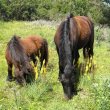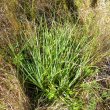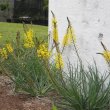| Botanical Name |
|
| Family |
Asphodeloideae - |
| Pronunciation |
bul-BIN-ee ass-foe-duh-LOY-deez |
| Common Name(s) |
English: Copaiva; Snake Flower
Afrikaans: Balsamkopieva; Geelkatstert; Kopieva; Wilde Kapiefa; Wildekopieva
IsiXhosa: intelezi; itswelemyoka
IsiZulu: ibhucu; ithethe Elimpofu
Sesotho: Khomo-ya-ntsuka; Moetsa-mollo; Pekane
|
| Plant Group |
- Succulent A plant having fleshy stems or leaves often adapted to dry conditions.
|
| Plant Size |
- Small to Medium
| Tree | 8m to 15m |
| Shrub | 75cm to 1m |
| Perennial/ground cover | 20cm to 40cm |
| Bulb | 30cm to 40cm |
| Succulent | 20cm to 40cm |
|
| Position |
- Sun The area is in full sun for all or most of the day, all year round.
|
| General Information |
- Drought Tolerance: High The plant is well adapted to arid conditions; it can survive long periods of drought and high temperatures without extra water.
- Evergreen Plants that have leaves all year round.
- Frost: Half-hardy The plant is able to survive low temperatures and some frost but requires protection against severe frost.
- Water Wise Plant species originating from low rainfall regions that require less water to survive and thrive than other plant species.
- Wind Tolerant Plants able to withstand the effect of strong winds.
|
| Specific Information |
Bulbine asphodeloides is a common species of bulbine found in many parts of South Africa but seldom seen in gardens. I have found it makes a useful garden subject but resents being transplanted and takes a while to recover. The best plants are those that have seeded themselves and are left where they are. The flowering period can be appreciably lengthened if the faded heads are removed before the seed ripens. At the speed with which they put out new flower heads, this can become quite a task! The flowers are invariably abuzz with bees.
|
| Ad Break |
|
| Flowers |
| Description |
small star-shaped flowers on a tall square-shaped stem
|
| Season |
- All Year Plants will seldom bloom for the entire season as given in the list, but should flower during a period within these parameters.
- Summer to Autumn Plants will seldom bloom for the entire season as given in the list, but should flower during a period within these parameters.
|
| Colour |
|
| Growth Rate |
- Moderate to Fast Specifying growth rate can be very misleading as there is considerable variation of growth rate depending on type and species of plant, available water, supplementary feeding, mulching and general care, as well as the plants suitability and adaptability to the garden environment.
|
| Plant Uses |
- Attracts bees, butterflies or other insects This plant attracts insects which can be food for birds or other creatures in your garden.
- Border A strip of ground, at the edge of a driveway or path in which ornamental plants or shrubs are planted.
- Container Trees, shrubs and ornamental species that can adapt to growing in a restricted environment.
- Filler Either a fast growing tree or shrub used temporarily to fill in an area while the permanent plants grow to a desired size, or a plant used to fill gaps in borders or beds.
- Ground Cover Low-lying plants that spread fast, require minimal maintenance, and cover large expanses or bare areas between bulbs or shrubs. They provide protection from erosion and drought and improve the visual appearance of the garden.
- Interplanting Arranging and planting plants in the garden that have different blooming times and habits of growth, extending the amount of time in which the area is in flower.
- Mass Planting Plants useful for filling a large area with just one or a few kinds of plants spaced close together. Creates a bold, dramatic effect and to reduces maintenance.
- Rock Garden An area constructed of larger rocks, arranged naturally, to emphasise the use of stones as a main element. Generally plants used do not need a lot of care.
- Stabilize Banks Plant is used to prevent soil erosion because their roots will form a mat that stabilizes the soil and keeps it from washing away in heavy rains.
- Wild Garden An indigenous garden planted for the benefit of wildlife and birds. Provides food, water, a variety of mini-biomes and no poisonous chemicals are used.
|
| Distribution and Habitat |
in the provinces of the Northern Cape, Western Cape, Eastern Cape, KwaZulu-Natal, Free State, Gauteng, and North West, as well as Lesotho, Swaziland and Mozambique, in grasslands and semi-karoid areas
|
| Planting Suggestions |
Divide clumps in winter and plant in sandy, well-drained soil with an application of compost if the soil is very impoverished. Seeds itself but not invasively. Grows best when left alone.
|
| Medicinal Uses |
The Xhosa people have been known to infuse the root in milk for treating bilharzia. The leaf sap of Bulbine asphodeloides is applied to promote wound healing. A decoction of the rhizomes is drunk to cure scrophula (a form of tuberculosis affecting the lymph nodes, especially of the neck), venereal diseases and diarrhoea.
|
| Ad Break |
|










Comments
snake flower
Hi
I am moving down from Gauteng in February to Bushmans Creek, and will be doing only indigenous in my barden.
but as its in a nature area the snakes are common.
will this plant planted on the extremities of my garden keep tthe snakes at bay, or can you suggest others.
thanks
Annie
Snake repellent plants
Hi Annie
The common name of 'Snake flower' refers to the way in which the tall flower stems move in the wind and have nothing to do with keeping snakes at bay.
The only plants I have come across that are mentioned as 'snake repellent' are Tulbaghia violacea (Wild garlic), Plectranthus neochilus (Lobster flower) and Pelargonium quercifolium (Muishondbos). This information came by word of mouth from traditional healers some time in the past century or two. There are no experiments, studies or literature backing up these claims and the use of these plants seems to have been limited to small, rural areas. I have in fact found a nice sized Puff adder lurking in my Wild garlic, so I am a bit cautious about the efficiency of these plants.
Having spent most of my life in Johannesburg, I was also somewhat concerned about snakes as I have a large property, most of which is wild veld. However, we hardly ever see the snakes. Snakes usually enter a house in hot weather to find a cool spot, or in cold weather to find a warm spot. To prevent them from entering the house, all my external doors are stable doors, and the unbendable rule is that the lower half of the door is kept closed at all times. We also removed all garden beds and shrubs from around the house - naked but necessary. Woodpiles, compost beds, brick piles and the like are also stored well away from the house.
My sons really kicked against the door rule until I found the discarded skin of quite a large snake under the drain cover next to the back door. Since then the lower doors have been closed.
Kind regards
Lorraine
Discuss this plant
Share knowledge, ask a question or give an experience.